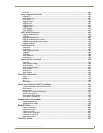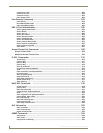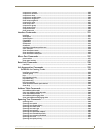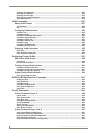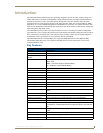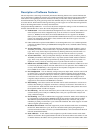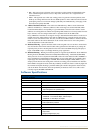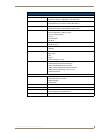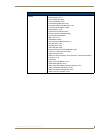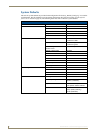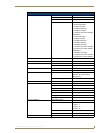
Introduction
3
NXA-ENET24 - Software Management Guide
addresses can be used to provide network security by restricting access for a known host to a
specific port.
IEEE 802.1D Bridge – The switch supports IEEE 802.1D transparent bridging. The address table
facilitates data switching by learning addresses, and then filtering or forwarding traffic based on
this information. The address table supports up to 8K addresses.
Store-and-Forward Switching – The switch copies each frame into its memory before forwarding
them to another port. This ensures that all frames are a standard Ethernet size and have been
verified for accuracy with the cyclic redundancy check (CRC). This prevents bad frames from
entering the network and wasting bandwidth.
To avoid dropping frames on congested ports, the switch provides 8 MB for frame buffering. This
buffer can queue packets awaiting transmission on congested networks.
Spanning Tree Protocol – The switch supports these spanning tree protocols:
Spanning Tree Protocol (STP, IEEE 802.1D) – This protocol adds a level of fault tolerance by
allowing two or more redundant connections to be created between a pair of LAN segments. When
there are multiple physical paths between segments, this protocol will choose a single path and
disable all others to ensure that only one route exists between any two stations on the network. This
prevents the creation of network loops. However, if the chosen path should fail for any reason, an
alternate path will be activated to maintain the connection.
Rapid Spanning Tree Protocol (RSTP, IEEE 802.1w) – This protocol reduces the convergence time
for network topology changes to about 10% of that required by the older IEEE 802.1D STP
standard. It is intended as a complete replacement for STP, but can still inter-operate with switches
running the older standard by automatically reconfiguring ports to STP-compliant mode if they
detect STP protocol messages from attached devices.
Virtual LANs – The switch supports up to 255 VLANs. A Virtual LAN is a collection of network
nodes that share the same collision domain regardless of their physical location or connection point
in the network. The switch supports tagged VLANs based on the IEEE 802.1Q standard. Members
of VLAN groups can be manually assigned to a specific set of VLANs. This allows the switch to
restrict traffic to the VLAN groups to which a user has been assigned. By segmenting your network
into VLANs, you can:
Eliminate broadcast storms which severely degrade performance in a flat network.
Simplify network management for node changes/moves by remotely configuring VLAN
membership for any port, rather than having to manually change the network connection.
Provide data security by restricting all traffic to the originating VLAN, except where a connection
is explicitly defined via the switch’s routing service.
Use private VLANs to restrict traffic to pass only between data ports and the uplink ports, thereby
isolating adjacent ports within the same VLAN, and allowing you to limit the total number of
VLANs that need to be configured.
Traffic Prioritization – This switch prioritizes each packet based on the required level of service,
using four priority queues with strict or Weighted Round Robin Queuing. It uses IEEE 802.1p and
802.1Q tags to prioritize incoming traffic based on input from the end-station application. These
functions can
be used to provide independent priorities for delay-sensitive data (video) and best-
effort data
(e-mail).
This switch also supports several common methods of prioritizing layer 3/4 traffic to meet
application requirements. Traffic can be prioritized based on the priority bits in the IP frame’s Type
of Service (ToS) octet or the number of the TCP/UDP port. When these services are enabled, the
priorities are mapped to a Class of Service value by the switch, and the traffic then sent to the
corresponding output queue.
IP Routing – The switch provides Layer 3 IP routing. To maintain a high rate of throughput, the
switch forwards all traffic passing within the same segment, and routes only traffic that passes
between different subnetworks. The wire-speed routing provided by this switch lets you easily link
network segments or VLANs together without having to deal with the bottlenecks or configuration
hassles normally associated with conventional routers.
Routing for unicast traffic is supported with the Routing Information Protocol (RIP) and the Open
Shortest Path First (OSPF) protocol.



